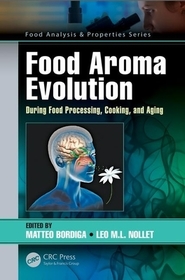
Food Aroma Evolution
During Food Processing, Cooking, and Aging
Sorozatcím: Food Analysis & Properties;
-
20% KEDVEZMÉNY?
- A kedvezmény csak az 'Értesítés a kedvenc témákról' hírlevelünk címzettjeinek rendeléseire érvényes.
- Kiadói listaár GBP 220.00
-
105 105 Ft (100 100 Ft + 5% áfa)
Az ár azért becsült, mert a rendelés pillanatában nem lehet pontosan tudni, hogy a beérkezéskor milyen lesz a forint árfolyama az adott termék eredeti devizájához képest. Ha a forint romlana, kissé többet, ha javulna, kissé kevesebbet kell majd fizetnie.
- Kedvezmény(ek) 20% (cc. 21 021 Ft off)
- Kedvezményes ár 84 084 Ft (80 080 Ft + 5% áfa)
Iratkozzon fel most és részesüljön kedvezőbb árainkból!
Feliratkozom
105 105 Ft

Beszerezhetőség
Becsült beszerzési idő: A Prosperónál jelenleg nincsen raktáron, de a kiadónál igen. Beszerzés kb. 3-5 hét..
A Prosperónál jelenleg nincsen raktáron.
Why don't you give exact delivery time?
A beszerzés időigényét az eddigi tapasztalatokra alapozva adjuk meg. Azért becsült, mert a terméket külföldről hozzuk be, így a kiadó kiszolgálásának pillanatnyi gyorsaságától is függ. A megadottnál gyorsabb és lassabb szállítás is elképzelhető, de mindent megteszünk, hogy Ön a lehető leghamarabb jusson hozzá a termékhez.
A termék adatai:
- Kiadás sorszáma 1
- Kiadó CRC Press
- Megjelenés dátuma 2019. december 2.
- ISBN 9781138338241
- Kötéstípus Keménykötés
- Terjedelem744 oldal
- Méret 254x178 mm
- Súly 1490 g
- Nyelv angol
- Illusztrációk 75 Illustrations, black & white 17
Kategóriák
Rövid leírás:
Of the five senses, smell is the most direct and food aromas are the key drivers of our flavor experience. They are crucial for the synergy of food and drinks. Up to 80% of what we call taste is actually aroma. This book deals with how food aromas are developed and affected during food processing, cooking, and aging.
TöbbHosszú leírás:
Of the five senses, smell is the most direct and food aromas are the key drivers of our flavor experience. They are crucial for the synergy of food and drinks. Up to 80% of what we call taste is actually aroma. Food Aroma Evolution: During Food Processing, Cooking, and Aging focuses on the description of the aroma evolution in several food matrices. Not only cooking, but also processing (such as fermentation) and aging are responsible for food aroma evolution. A comprehensive evaluation of foods requires that analytical techniques keep pace with the available technology. As a result, a major objective in the chemistry of food aroma is concerned with the application and continual development of analytical methods. This particularly important aspect is discussed in depth in a dedicated section of the book.
Features
- Covers aromatic evolution of food as it is affected by treatment
- Focuses on food processing, cooking, and aging
- Describes both classic and new analytical techniques
- Explains how the flavor perception results are influenced by other food constituents
The book comprises a good mix of referenced research with practical applications, also reporting case studies of these various applications of novel technologies. This text represents a comprehensive reference book for students, educators, researchers, food processors, and food industry personnel providing an up-to-date insight. The range of techniques and materials covered provides engineers and scientists working in the food industry with a valuable resource for their work.
Also available in the Food Analysis & Properties Series:
Ambient Mass Spectroscopy Techniques in Food and the Environment, edited by Leo M.L. Nollet and Basil K. Munjanja (ISBN: 9781138505568)
Hyperspectral Imaging Analysis and Applications for Food Quality, edited by N.C. Basantia, Leo M.L. Nollet, and Mohammed Kamruzzaman (ISBN: 9781138630796)
Fingerprinting Techniques in Food Authentication and Traceability, edited by Khwaja Salahuddin Siddiqi and Leo M.L. Nollet (ISBN: 9781138197671)
For a complete list of books in this series, please visit our website at:
www.crcpress.com/Food-Analysis--Properties/book-series/CRCFOODANPRO
TöbbTartalomjegyzék:
SECTION I: Aroma, taste, and flavor. 1.Aroma and Odor. 2. Flavors and Taste. 3. Chemical Senses and Flavor Perception. 4. Aroma Compounds (Description, Biosynthesis, and Regulation). 5. Orthonasal and Retronasal Olfaction. SECTION II: Analytical techniques. 6. Extraction Methods and Volatile Compounds from Food Matrices. 7. The Role of Gas Chromatography-Based Methodologies for Understanding of Food Aromas. 8. Monitoring Food Aroma during Processing and Storage by Rapid Analytical Methods: A Focus on Electronic Noses and Mass Spectrometry-Based Systems. 9. Hyphenated Electronic Nose Technique for Aroma Analysis of Foods and Beverages. 10.Food Aroma Compounds by Capillary Electrophoresis. 11. Proton-Transfer-Reaction–Mass Spectrometry. 12. Stable Isotope Dilution Assay. SECTION III: Principles of processing, evolution, and modification. 13. Food Processing, Cooking, and Aging: A Practical Case Study. 14. The Maillard Reaction. 15. Production of Food Aroma Compounds (Microbial and Enzymatic Methodologies). 16. Novel and Emerging Technologies (Benefits and Limitations). SECTION IV: Aroma compounds in food matrices. 17. Distallates. 18. Evolution of Beer Aroma. 19. Coffee Flavor. 20. Aroma Evolution in Chocolate Production. 21. Bakery Products. 22. Recent Advances in the Study of Grape and Wine Volatile Composition: Varietal, Fermentative, and Aging Aroma Compounds. 23. Milk/Dairy. 24. Meat. 25. Fish. 26. Fruits and Vegetables. 27. Spices and Herbs. 28. Off-Flavors in Alcoholic Beverages: An Overview. SECTION V: Influences on flavor perception. 29. Interactions between the Food Matrix and Aroma Compounds in Relation to Perception. 30. Food Emulsions as Flavor Delivery Systems. 31. Relationship between Structure and Odor. 32. Bioactive Potential of Sesquiterpenes.
Több



